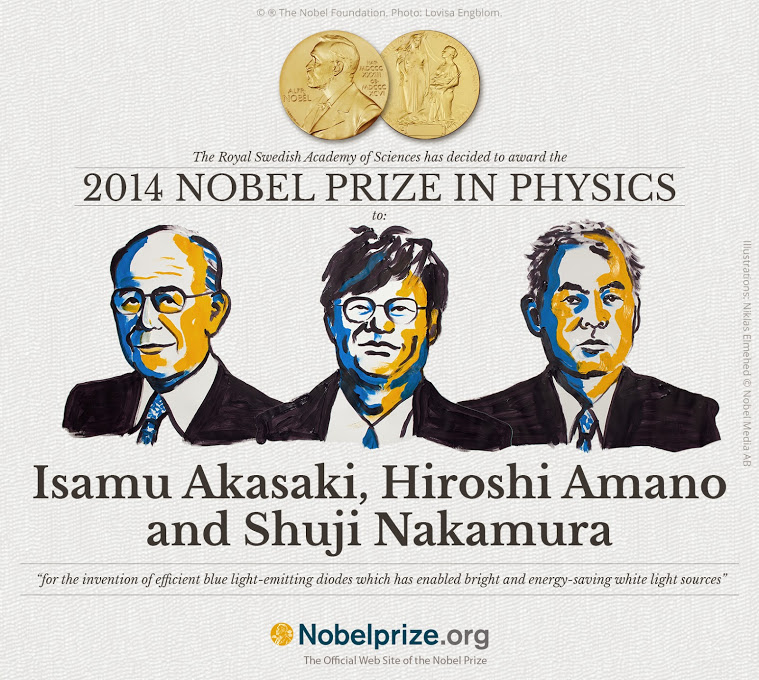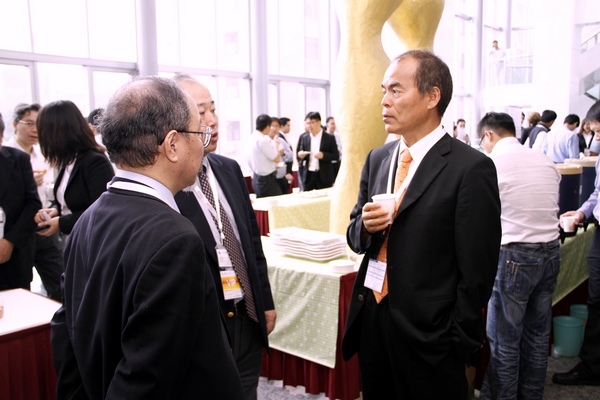This year’s Nobel Prize in Physics was shared between three Japanese blue LED inventors Isamu Akasaki, Hiroshi Amano and Shuji Nakamura. The three inventors were recognized for their achievements in the highly energy efficient blue LED, which led to the emergence of white light.
Red and green LEDs have been around for nearly half a century, but developments in blue LEDs were obstructed by technological difficulties. Without blue lights, white lamps could not be made. Many scientists and industry experts tried to manufacture blue LEDs, but no one succeeded for 30 years.
 |
|
This year's Nobel Prize in Physics was awarded the the Japanese trio Isamu Akasaki, Hiroshi Amano and Shuji Nakamura for their work in blue LEDs. (Image Credit: Nobelprize.org) |
It was not until early 1990s that Akasaki and Amano developed Gallium Nitride (GaN) LED at Nagoya University, while Nakamura developed the LED during his employment in Nichia Chemical (Nichia) at the time. Their inventions revolutionized lighting in the 21st century, by replacing the chemically hazardous incandescent lamps with LED lamps. The Nobel Prize has been awarded to the three scientists just 20 years after the three developed blue GaN LED.
 |
|
Blue GaN LED inventor Professor Hiroshi Amano of Nagoya University (left) with Aledia CEO Giorgio Anania (right). (Photo Credit: Aledia) |
Akasaki is currently a professor at Meijo University, Nagoya, Japan and Nagoya University, Japan, while Amano
is a professor at Nagoya University, Japan. Nakamura, who has been coined as the “Father of GaN Blue LED”, is now a professor at University of California, Santa Barbara, U.S. The 8 million Swedish Krona (US $1.11 million) Nobel Prize money will be split among the three laureates.
“I am very honored to receive the Nobel Prize from The Royal Swedish Academy of Science for my invention of the blue LED,” said Nakamura. “It is very satisfying to see that my dream of LED lighting has become a reality. I hope that energy-efficient LED light bulbs will help reduce energy use and lower the cost of lighting worldwide.”
 |
|
Shuji Nakamura was elated to learn he had won the Nobel Prize Award. He later went on to found LED startup company Soraa. (Photo Credit: Soraa) |
Events leading to Shuji Nakamura and Nichia’s lawsuit
Nakamura has been a pioneer in changing old practices in Japan’s R&D industry. Commercialization of blue LED happened in a relatively short period of time from 1993 to 1994. After graduating from University of Tokushima, Nakamura began working at the Tokushima-based Nichia. It was during his time at Nichia that he developed blue GaN LEDs using the more cost effective doping method (low-temperature heating). Nakamura threatened his supervisors that he would resign if they did not provide him with resources to develop GaN, which is the key material to developing blue LEDs. After successfully manufacturing blue LEDs in 1994, Nichia went on to develop commercialized green LEDs the following year, and laser diodes (LD) in 1999. After Nakamura left Nichia Chemical, the University of California, Santa Barbara hired him as a professor.
Nichia was able to acquire many key LED patents and sell high quality LEDs because of scientists, such as Nakamura. The scientist shook the Japanese technology industry in 2001, when he filed a lawsuit against Nichia seeking US $180 million in compensation for his LED invention. The company was reported to have only given Nakamura US $180 for his blue GaN LED invention when he left the company in the 1990s. According to a Wall Street Journal report, foreign researchers and inventors even coined him as “Slave Nakamura” when they learned how little the devoted salaryman was earning in Nichia. Despite using Nichia resources to develop blue GaN LEDs, Nakamura believed he was the rightful patent holder and inventor, and should be compensated for his work.
The lawsuit created quite an uproar that year. The Tokyo District Court ruled Nichia should pay at least 60.4 billion Japanese Yen (US $560 million) to Nakamura for his contributions in blue LEDs, but lowered the compensation sum to 20 billion Japanese Yen after taking into consideration Nakamura had only asked for that much in the complaint. The court estimated Nichia earned a profit totaling 120 billion Japanese Yen from the blue LED patent invention alone, and initially based the compensation sum on Nakamura’s contributions reaching 50 percent of company profits. Nichia appealed to the initial ruling and the lawsuit dragged on for years before the two parties finally agreed to settle for 844 million Japanese Yen compensation on Jan. 11, 2005. The lawsuit set a precedent in Japan for employees suing employers.
 |
|
Shuji Nakamura chats with fellow attendees during LEDforum 2011. Nakamura was a guest speaker at the annual event hosted by LEDinside that year. (LEDinside) |
Nakamura’s departure from Japan enables LED technology to blossom in foreign markets
Many LED manufacturers were stunned when Nakamura developed the first blue LED because Nichia’s LEDs were reliability and robustness was far superior. It took other LED manufacturers several years before they could catch up with Nichia’s white LED and blue LED achievements.
Even today, Nichia’s LEDs remain the top choice for LED backlight applications in Apple’s iPad, iPhone and high-end Android smartphone displays. Nichia still offers better quality LEDs for backlight applications, compared to other manufacturers, whether it’s the LED size, brightness, luminous efficacy, or reliability wise.
Nakamura’s decision to pursue an American dream and leave Japan was not just an academic decision, but also had to do with his complicated feelings towards former employer Nichia. The two sides had very different perspectives on the blue LED patent lawsuit outcome. Nakamura “indirectly” assisted U.S. manufacturer Cree in developing high-power LED, and later formed an academic partnership with Korean LED manufacturer Seoul Semiconductor. Some of Seoul Semiconductor’s new products were based on Nakamura’s research results, which is especially ironic for Nichia.
If Nichia valued Nakamura’s research results, hard work, and gave him the payment he deserved, the company could have maintained its leadership position in the LED industry. For R&D staff in the scientific industry, it is important for their expertise to be valued. If most companies treated R&D staff in the same way as Nichia did to Nakamura, than it is probably not surprising that employees may decide to leave or even take legal action against the company.
(Author: Angela Yang, Reporter, LEDinsidehttp://Editor: Judy Lin, Chief Editor, LEDinside)





 CN
TW
EN
CN
TW
EN






